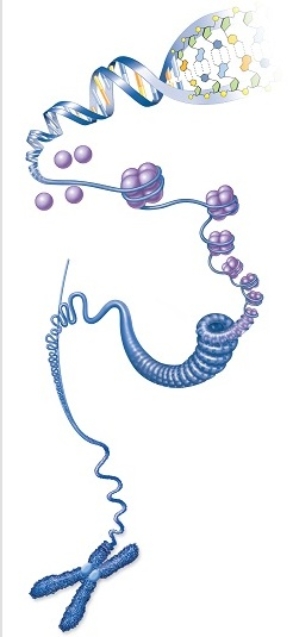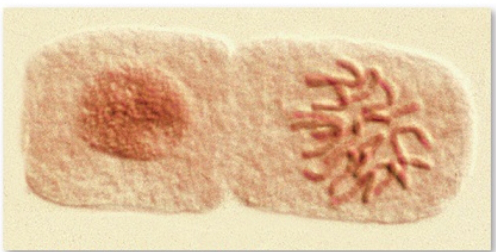A) because DNA synthesis always goes from 5' to 3'
B) because DNA polymerase only attaches nucleotides to the 3' end of strands
C) because DNA synthesis can grow off of either the 3' or 5' end
D) because DNA synthesis always goes from 3' to 5'
E) Both answers, with DNA synthesis proceeding from 5' to 3', and DNA polymerase only acting on the 3' end, are correct.
Correct Answer

verified
Correct Answer
verified
Multiple Choice
Figuer:
This diagram shows how DNA is packaged and folded with its associated protective and regulatory proteins.  -DNA is packaged to protect and manage the genetic information of the cell.What is the correct comparison between the packaging units of DNA?
-DNA is packaged to protect and manage the genetic information of the cell.What is the correct comparison between the packaging units of DNA?
A) While chromatin is the collective term for the substance of DNA and associated proteins, chromosomes are the distinct units that are compact and visible during cell division.
B) While chromosome is the collective term for the substance of DNA and associated proteins, chromatin is the fluid and other molecules in the nucleus, that regulate cell division.
C) While the nucleus contains chromatin substance in general, the nucleosome is a secondary compartment that forms prior to cell division, as a location where chromosomes will replicate and divide.
D) Chromosomes are the distinct folded units containing the DNA molecule, while chromatin in the nucleosome is the location of the associated proteins.
E) The histones are protective proteins in chromatids, but the nucleosomes and centromeres are part of the actively dividing chromosomes.
Correct Answer

verified
Correct Answer
verified
Multiple Choice
In a biology lab exercise,you are asked to examine cells of a growing onion root tip,that has been sectioned to show many cells.In most of the cells,you easily see the circular or oval nucleus as a uniformly filled space in a membrane outline.In a small percentage of cells,you see chromosomes as distinct strands just as cell division begins,and as it progresses,because the chromatin

A) becomes more tightly folded, increasing their visible length.
B) becomes less tightly folded, increasing their visible length.
C) becomes less tightly wound, to facilitate cell division.
D) becomes more tightly wound, to protect DNA, and to more easily manage cell division.
E) increases in length, as replication adds DNA sections to the original.
Correct Answer

verified
Correct Answer
verified
Multiple Choice
How does the space between our fingers arise?
A) The cells die by necrosis.
B) Mitosis of the cells is blocked.
C) The cells die by apoptosis.
D) The cells become part of the fingers.
E) Meiosis of the cells is blocked.
Correct Answer

verified
Correct Answer
verified
Multiple Choice
Sister chromatids are
A) genetically identical and attached to each other at the centromere.
B) genetically different and attached to each other at the centromere.
C) genetically identical.
D) genetically different.
E) attached to each other at the centromere.
Correct Answer

verified
Correct Answer
verified
Multiple Choice
Complementary DNA strands are held together by
A) ionic bonds.
B) hydrogen bonds.
C) covalent bonds.
D) phosphodiester bonds.
Correct Answer

verified
Correct Answer
verified
Multiple Choice
A human heart cell contains ___ chromatids.
A) 4
B) 46
C) 23
D) 2
E) 16
Correct Answer

verified
Correct Answer
verified
True/False
The complement strands of DNA have the same exact nitrogen base sequence,providing the semiconservative replication needed by cells.
Correct Answer

verified
Correct Answer
verified
Multiple Choice
Meiosis is a process used for
A) growth of an organism.
B) repair of damaged cells.
C) production of gametes.
D) asexual reproduction.
E) production of stem cells.
Correct Answer

verified
Correct Answer
verified
Multiple Choice
Why don't plant cells form a cleavage furrow during cytokinesis?
A) because their cells don't divide after mitosis, but become one larger cell with multiple nuclei
B) because they don't have a cell membrane
C) because they have a cell wall
D) because they don't have a nucleus
E) All of the answer choices are correct.
Correct Answer

verified
C
Correct Answer
verified
Multiple Choice
If scientists could increase telomerase production in specific cells,the primary reason for this would most likely be the stopping of
A) aging of cells.
B) cancer cell formation.
C) aerobic respiration.
D) meiosis.
E) All of the answer choices are correct.
Correct Answer

verified
Correct Answer
verified
Multiple Choice
The correct sequence for the phases of the cell cycle,starting with a newly divided cell,is
A) cytokinesis - replication - interphase - mitosis.
B) interphase - mitosis - cytokinesis.
C) interphase - binary fission - cytokinesis.
D) replication - binary fission - cytokinesis.
E) cytokinesis - mitosis - interphase.
Correct Answer

verified
Correct Answer
verified
Multiple Choice
In the biology lab,you observe three different animal cells under a microscope.In one cell,the nucleus is uniformly filled,with no distinct chromosome structure visible.In another,you see the nucleus with two nucleolus areas of more compact chromatin.A third cell is in mitosis,and distinct chromosome strands are visible.The value in packaging DNA in tighter forms of chromatin is for
A) regulation and protection of the DNA during transcription.
B) Both answers regarding DNA mobility, protection and regulation in mitosis and transcription are correct.
C) prevention of ligase enzyme action during replication.
D) mobility and protection of the DNA molecule during mitosis.
E) insuring that sister chromatids will be attached prior to replication.
Correct Answer

verified
Correct Answer
verified
Multiple Choice
DNA replication is
A) a one-step process.
B) not carried out in prokaryotic cells.
C) not carried out by enzymes.
D) conservative.
E) semi-conservative.
Correct Answer

verified
Correct Answer
verified
True/False
Change in a cell's DNA sequence is a common occurrence in the process of replication.
Correct Answer

verified
Correct Answer
verified
True/False
Because prokaryotic cells do not go through interphase,mitosis,and cytokinesis,they do not replicate their DNA prior to division.
Correct Answer

verified
Correct Answer
verified
True/False
Replication takes place during the G1 phase of interphase.
Correct Answer

verified
False
Correct Answer
verified
Multiple Choice
Cyclophosphamide forms cross links between the two strands of DNA in a chromosome.How would this be effective in chemotherapy?
A) It would block splicing.
B) It would activate oncogenes.
C) It would block metaphase.
D) It would inactivate tumor suppressors.
E) It would block DNA replication.
Correct Answer

verified
E
Correct Answer
verified
Multiple Choice
Figuer:
This diagram shows how DNA is packaged and folded with its associated protective and regulatory proteins.  -A part of a chromosome,that attaches sister chromatids to each other,defines the term
-A part of a chromosome,that attaches sister chromatids to each other,defines the term
A) nucleosome.
B) None of the answer choices are correct.
C) chromatin.
D) histone.
E) centromere.
Correct Answer

verified
Correct Answer
verified
Multiple Choice
The enzyme that adds nucleotides along the 5' to 3' along a DNA strand,is
A) primase.
B) DNA polymerase.
C) helicase.
D) ligase.
E) ATP synthase.
Correct Answer

verified
Correct Answer
verified
Showing 1 - 20 of 83
Related Exams